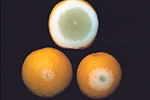Supplementary information:
Websites
1. Ritchie, D.F. 2000. Brown rot of stone fruit. The Plant Health Instructor. DOI: 10.1094/PHI-I-2000-1025-01
2. Illustrated Glossary of Plant Pathology by C.J. D’Arcy, D.M. Eastburn, and G.L. Schumann (in this website)
References:
Agrios, G.N. 2005. Plant Pathology, 5th Ed., Elsevier Academic Press, Burlington, MA. See "Brown Rot of Stone Fruits" on pp.507-510.
Brock, T.D. 1988. Robert Koch: A Life in Medicine and Bacteriology. Springer-Verlag, Berlin, Germany.
Carroll, J. E. 1994. Learning Biology with Plant Pathology. National Association of Biology Teachers, Reston, VA.
DeKruif, P. 1926. Microbe Hunters. Harcourt, Brace & Co., New York.
Kelman, A. and J.A. Philips. 1989. Classroom demonstration of Koch’s postulates. ASM (American Society for Microbiology) News 55:603-606.
Lennox, J. 1985. The deceptively simple postulates of Professor Robert Koch. The American Biology Teacher 47:216-221. (This article discusses how Koch’s postulates are used to identify and confirm pathogens that cause infectious diseases in humans and animals. Sometimes this is a difficult process, for example, in the case of Legionnaires’ disease.)
Ogawa, J.M., E.I. Zehr, G.W. Bird, D.F. Ritchie, K. Uriu, and J.K. Uyemoto. 1995.. Compendium of Stone Fruit Diseases. APS Press, St. Paul, MN. See “Brown Rot” on pp.7-10.
Ringel, S. M. 1968. Demonstration of Koch’s postulates. The American Biology Teacher 30:527-528. (This article outlines how to demonstrate Koch’s postulates for another plant disease, green mold rot of oranges which is caused by a species of the fungus Penicillium. Green mold rot is a common postharvest disease of citrus fruit, so this is another one you may find in the grocery store.)
 |
Figure 14. Several stages of green mold on
sweet oranges. (Courtesy G. E. Brown)
lick image for a larger view. |
